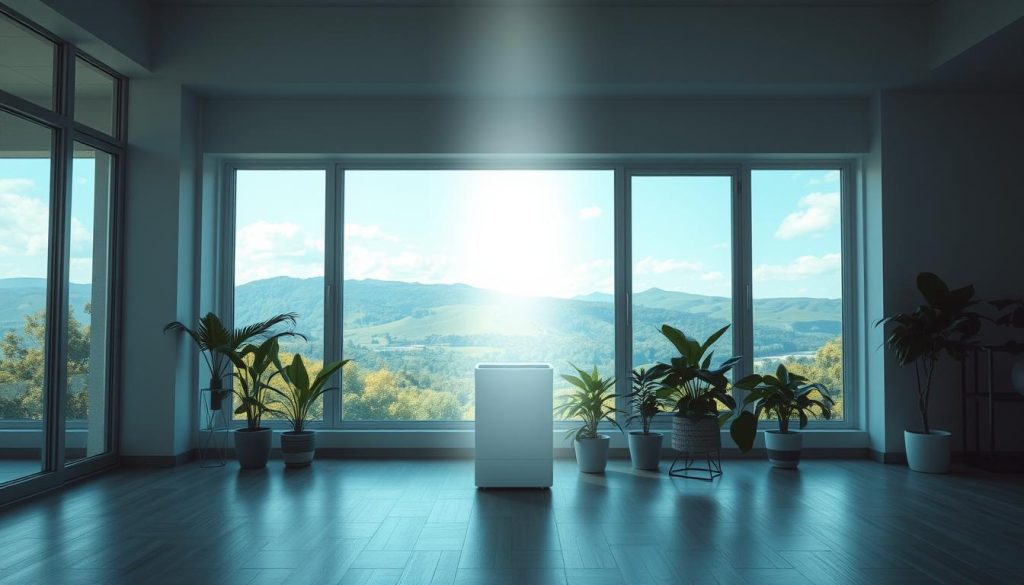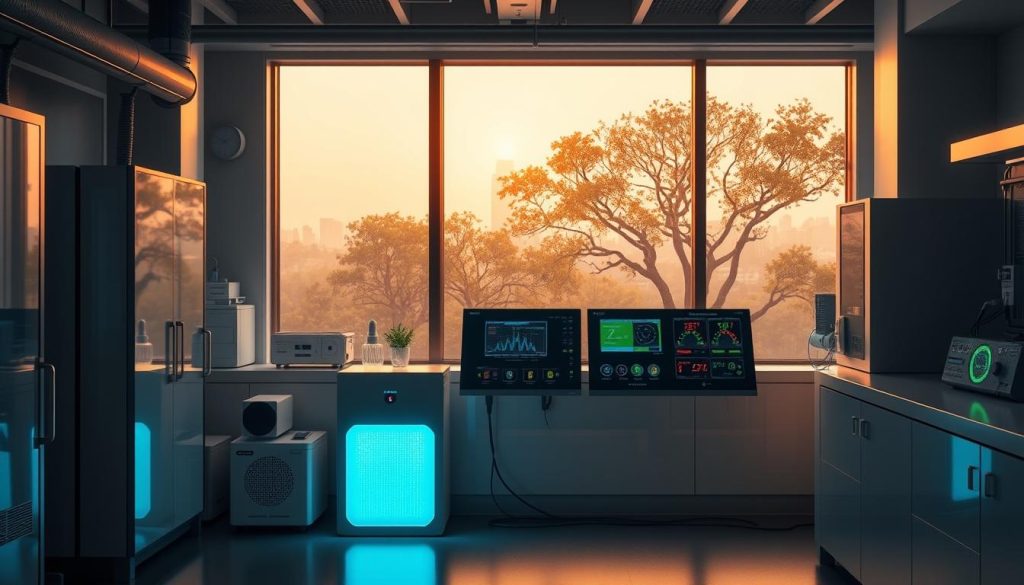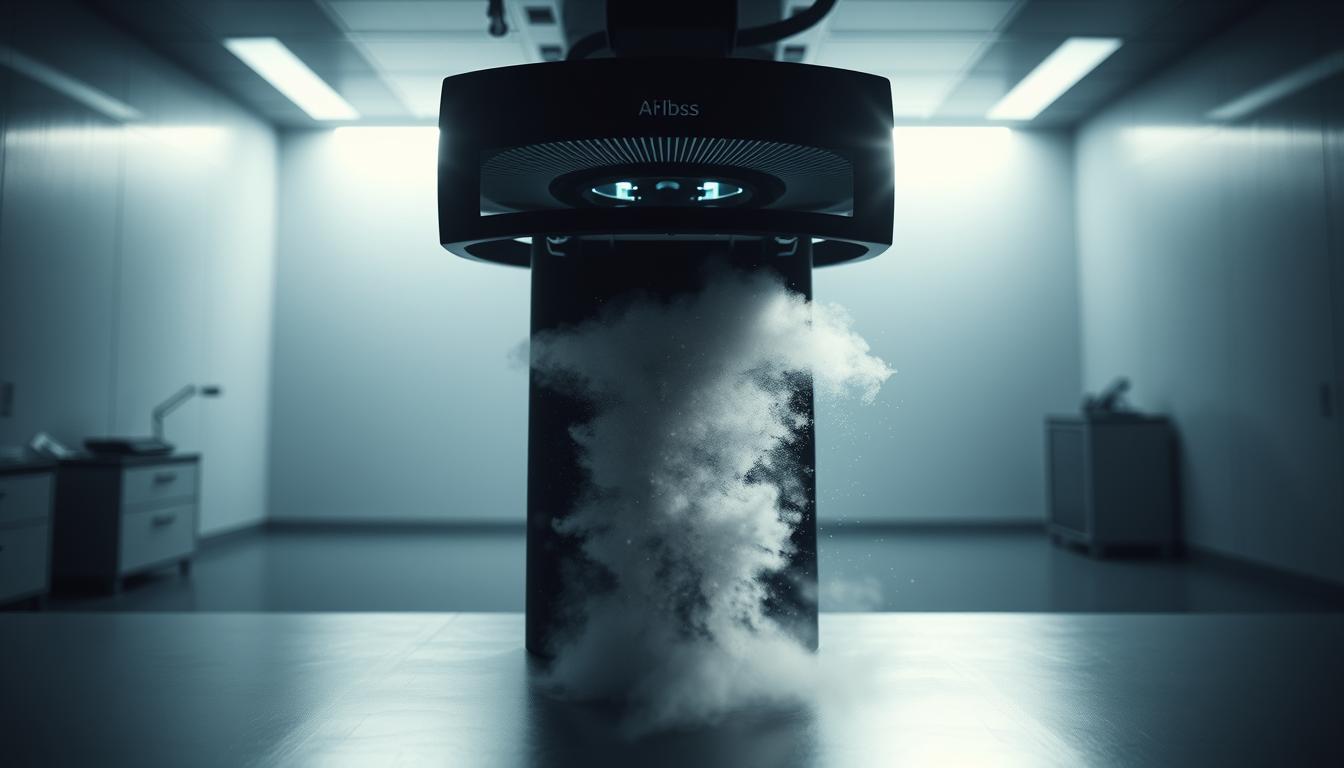Ever wondered how negative ions purify air and improve air quality? It’s important to understand their role in cleaning the air. This knowledge helps us see their impact on indoor spaces.
Negative ions are tiny particles that grab onto pollutants. This makes them disappear from the air we breathe. By using negative ions, we can make our homes cleaner and healthier. Let’s dive into the science behind negative ions and how they can improve your home’s air quality.
Understanding Negative Ions
Negative ions are fascinating particles that greatly affect the air we breathe. They are found in places like forests, waterfalls, and mountains. These ions form when molecules pick up an extra electron.
The presence of negative ions makes the air fresher and cleaner. This makes outdoor settings more pleasant and refreshing.
What Are Negative Ions?
Negative ions are oxygen atoms with an extra electron. They are common in natural settings where water and air move a lot. For example, the air around waterfalls and beaches is full of negative ions.
This abundance is why we often feel calm in these places.
The Science Behind Negative Ions
The science behind negative ions is quite interesting. When these ions enter the air, they stick to positively charged particles like dust and pollen. This makes these particles heavier and they fall to the ground.
This process cleans the air we breathe. Several studies have shown that negative ions can purify the air well. A study by the University of California found that negative ions reduce indoor pollutants.
This research highlights the importance of negative ions in improving air quality. It shows a promising way to fight pollution in different places.
How Negative Ions Purify Air
Negative ions act as natural air cleaners by sticking to airborne pollutants like dust, pollen, and smoke. An ionizer releases these negative ions into the air. They then bond with positively charged pollutants.
This bond makes the pollutants heavy, causing them to fall or stick to surfaces. This results in cleaner air to breathe.
Negative ions also help fight airborne diseases by neutralizing bacteria and viruses. This is good news for people with asthma and other breathing problems. Studies show that negative ions can reduce allergens in the air.
These ions make pollutants clump together, making them easier to clean. This method tackles many air quality issues, from allergens to harmful germs.
Benefits of Negative Ions for Air Quality
In recent years, negative ions have become key in improving indoor air quality. These ions, or anions, help purify the air we breathe. This makes our environment healthier and more eco-friendly.
Health Benefits of Negative Ions
Negative ions can greatly improve our respiratory health. They help reduce airborne allergens like pollen and dust mites. This makes the air cleaner and safer for us.
Studies also show that negative ions can boost our mood. They increase serotonin levels in the brain, helping to fight depression. So, using air purifiers that create negative ions can greatly benefit our well-being.

Environmental Impact of Negative Ions
Negative ions have a big impact on the environment too. Using air purifiers that create negative ions is eco-friendly. Unlike other methods, they don’t produce harmful byproducts.
This keeps the air clean and safe indoors. It also supports natural processes that refresh our environment. Choosing negative ion generators is a sustainable and effective way to purify the air.
Negative Ion Generators: How Do They Work?
Negative ion generators are key to better air quality. They use different methods to make negative ions. These devices help keep the air clean and healthy in homes and offices.
These generators create negative ions by adding electrons to air molecules. The main way they do this is through corona discharge. This method uses a high-voltage electrode to send electrons into the air, turning oxygen into negative ions.
Another way is using radioactive sources, like polonium. These sources naturally create negative ions when they interact with air. But, this method is not as common because of safety worries.
Some generators also use ultraviolet (UV) radiation. UV lamps make negative ions by ionizing air molecules. This is safer than radioactive methods and is used more in new air cleaners.
It’s clear that negative ion generators are safe for use at home and in businesses. They are designed to not make too much ozone, which is good for health. Studies show they can really improve indoor air quality by cutting down on dust, pollen, and bacteria.
Different Types of Ionizers for Air Purification
Choosing the right ionizer is key to better air quality. Knowing the different types helps you pick the best one for you. We’ll look at portable ionizers, whole-home air systems, and personal ionization devices.
Portable Ionizers
Portable ionizers are small and easy to carry. They’re great for cars or small rooms. They’re also good for people who travel a lot.
They often have USB charging and need little upkeep. They focus on cleaning air in a small area well.
Whole-House Ionizers
Whole-home air systems purify air throughout your home. They fit into your HVAC system. This way, every room gets cleaner air.
They’re best for big homes or businesses. They have features like automated control and high capacity.
Wearable Ionizers
Wearable ionizers are for personal use. They’re small and you wear them around your neck. They create a clean air zone around you.
They’re perfect for places with bad air. Despite their size, they’re good at removing particles and pollutants.
Think about your space, budget, and air quality needs when choosing. Portable, whole-home, or personal ionizers all have benefits. They can all improve your air quality.
The Role of Negative Ions in Nature
Negative ions are key to clean outdoor air and better health. They are made naturally in many places. For example, near waterfalls, by the ocean, and after storms.
The power of water or a storm creates these ions. This makes the air we breathe cleaner.

Negative ions make the air feel fresh and lively. Studies show forests and mountains have lots of them. They help lower stress and improve mood.
Being around negative ions is good for our lungs and overall health. It makes us feel more alive.
Nature’s way of cleaning the air has led to indoor devices. These negative ion generators aim to bring outdoor air quality inside. They help us understand the importance of negative ions in keeping our air clean.
Negative Ions and Indoor Air Quality
Keeping the air inside clean is key for our health. Indoors, we face many air pollutants like dust, pollen, and chemicals. These can make the air unhealthy in places we spend a lot of time, like homes and offices.
Negative ions help clean the air by sticking to pollutants. This makes them too heavy to stay in the air. So, the air inside becomes cleaner. They also help reduce harmful germs and allergens.
Using negative ion generators can greatly improve the air inside. They are very helpful in *office air purification*. This is because offices often have poor air circulation.
Studies show that negative ions can make a big difference at home. They help reduce breathing problems and improve air quality. This is great for rooms with bad air and little ventilation.
Using negative ions is a smart way to keep the air clean indoors. It helps make our living and working spaces healthier. Negative ion technology is a good way to breathe easier at home or in the office.
Choosing the Right Ionizer for Your Needs
Choosing the right ionizer can greatly improve your indoor air quality. It’s important to know what to look for before making a choice. This will help you find an air purifier that meets your needs.
Factors to Consider When Buying an Ionizer
When picking an ionizer, think about the room size, ion output, safety features, and cost. Make sure the ionizer fits the space you want to clean. For bigger areas, more ion output is better.
Look for safety features to ensure it’s safe to use. Also, consider the cost and what you get for it. This will help you find the best value.
Top Brands and Models of Ionizers
Dyson, Sharp, and Blueair are top brands known for their quality and design. Dyson’s Pure Cool series offers great air purification and cooling. Sharp’s Plasmacluster technology removes allergens and pollutants well.
Blueair’s HealthProtect line combines strong filtration and ionization. Users love these brands for their reliability and effectiveness.
Maintenance Tips for Ionizers
Keeping your ionizers in good shape is key for their performance and life. Clean the filters and ionizing plates often. Replace parts as the manufacturer suggests. Also, keep the device in a clean area.
These steps will keep your air purifiers working well and efficiently.
Combining Negative Ionization with Other Air Purification Methods
Using negative ionization with HEPA filters and activated carbon creates a powerful air cleaning system. This mix tackles a wide range of pollutants. It leads to cleaner, healthier air inside homes and offices.

Negative ionization works well against airborne particles. But, adding HEPA filters catches more dust, pollen, and pet dander. HEPA filters can trap up to 99.97% of particles as small as 0.3 microns.
Negative ions help make smaller particles bigger, making them easier for HEPA filters to catch. This combo is key to removing many types of particles.
Activated carbon filters also play a big role. They soak up harmful gases, odors, and VOCs that other methods might not get. Using different air cleaning methods together ensures a more complete clean.
Devices like the Molekule Air Purifier show how well these methods work together. It uses PECO technology and filters for top-notch air cleaning. Dyson’s air purifiers also combine HEPA, activated carbon, and air ionizers for the best air quality.
By using many air cleaning methods together, we can fight indoor air pollution better. This approach makes the air we breathe cleaner and safer.
| Technology | Function | Target Pollutants |
|---|---|---|
| Negative Ionization | Clumps small particles | Dust, pollen, smoke |
| HEPA Filtration | Captures 99.97% of particles ≥0.3 microns | Dust mites, mold spores, pet dander |
| Activated Carbon | Absorbs gases and VOCs | Odors, chemical fumes |
Common Misconceptions About Negative Ions
Negative ions often spark curiosity and doubt, leading to many misconceptions. It’s important to know the difference between negative and positive ions. This helps us see their real value in making the air better.
Negative Ions vs. Positive Ions
Many people mix up negative ions with positive ones. Negative ions, which are oxygen atoms with an extra electron, clean the air. Positive ions, lacking an electron, can make the air worse and harm our health. Knowing this difference helps clear up misconceptions and shows how negative ions improve air quality.
Myths and Facts About Negative Ions
The growth of ion therapy has brought up many myths. One big myth is that negative ions can fix all health problems. While they have many benefits, they are not a magic solution. Studies show that negative ions can boost mood and cut down on air pollution, but they’re not a cure-all.
By debunking these myths and sharing the real facts, we can truly understand their health benefits and limits.
Scientific Studies on Negative Ions and Air Quality
Research on negative ions and air quality is growing. Many studies show how negative ions can clean the air. They help remove dust, pollen, and some germs from the air.
A study by the National Institute of Environmental Health Sciences found a big drop in airborne bacteria. Negative ions cut bacterial contaminants by up to 95%. This shows how negative ions can improve air quality in closed spaces.
Studies give us important numbers. For example, a Journal of Electrostatics study found a 30% drop in pollution in 15 minutes. This proves negative ions are good at cleaning the air.
But, there are still things we don’t know. More research is needed to understand how long these effects last. We also need to know how they work in different places.
In short, studies support the use of negative ions to clean the air. But, we need to keep studying to learn more about their benefits.
Real Life Applications of Negative Ionization
Negative ionization technology is now used in many real-world situations. It’s found in home air ionization systems, commercial air cleaners, and industrial air quality control. Its benefits are clear across different fields.
Residential Use of Negative Ions
Homeowners can use home air ionization systems to clean the air. These systems cut down on allergens, dust, and pollutants. This makes homes healthier and can even help people sleep better and breathe easier.
Commercial Applications of Negative Ions
Commercial air cleaners with negative ionization are becoming popular. Offices, restaurants, and hotels use them to keep the air clean. This leads to happier customers and more productive employees. Studies show these systems really improve air quality.
Industrial Use of Negative Ions
In factories and warehouses, keeping the air clean is key. It’s good for workers’ health and helps things run smoothly. Negative ionization technology helps keep the air clean, reducing downtime and improving worker health.
Future Trends in Negative Air Ionization
The future of air purification is looking bright. New air cleaners will use advanced materials and designs. This means they’ll be better at removing pollutants from the air, making our homes healthier.
Another exciting trend is the connection of air ionizers with smart homes. As our homes get smarter, air purifiers will too. They’ll work better with other devices, making it easier to manage air quality.
Expect to see air purifiers that are also affordable and eco-friendly. Costs will drop thanks to new manufacturing methods. This change will help make clean air accessible to more people, benefiting our planet.

